Analysis of Nursing Staff Shortage in the US Healthcare System
VerifiedAdded on 2022/09/09
|5
|1621
|18
Essay
AI Summary
This essay examines the persistent issue of nursing staff shortages in the US healthcare system. It explores the causal factors contributing to this shortage, including increased patient acuity, hospital financial pressures, and the impact on both patient and nurse safety. The essay analyzes the implications of inadequate nurse-to-patient ratios, such as increased medical errors, extended hospital stays, nurse burnout, and decreased job morale. It then proposes potential solutions from the perspectives of nurse leaders, nurse managers, and administrative interventions, including advocating for appropriate nurse-patient ratios, securing additional funding, and implementing programs to support nursing education and workforce development. The analysis emphasizes the need for comprehensive strategies to improve patient care and create a more sustainable healthcare environment.
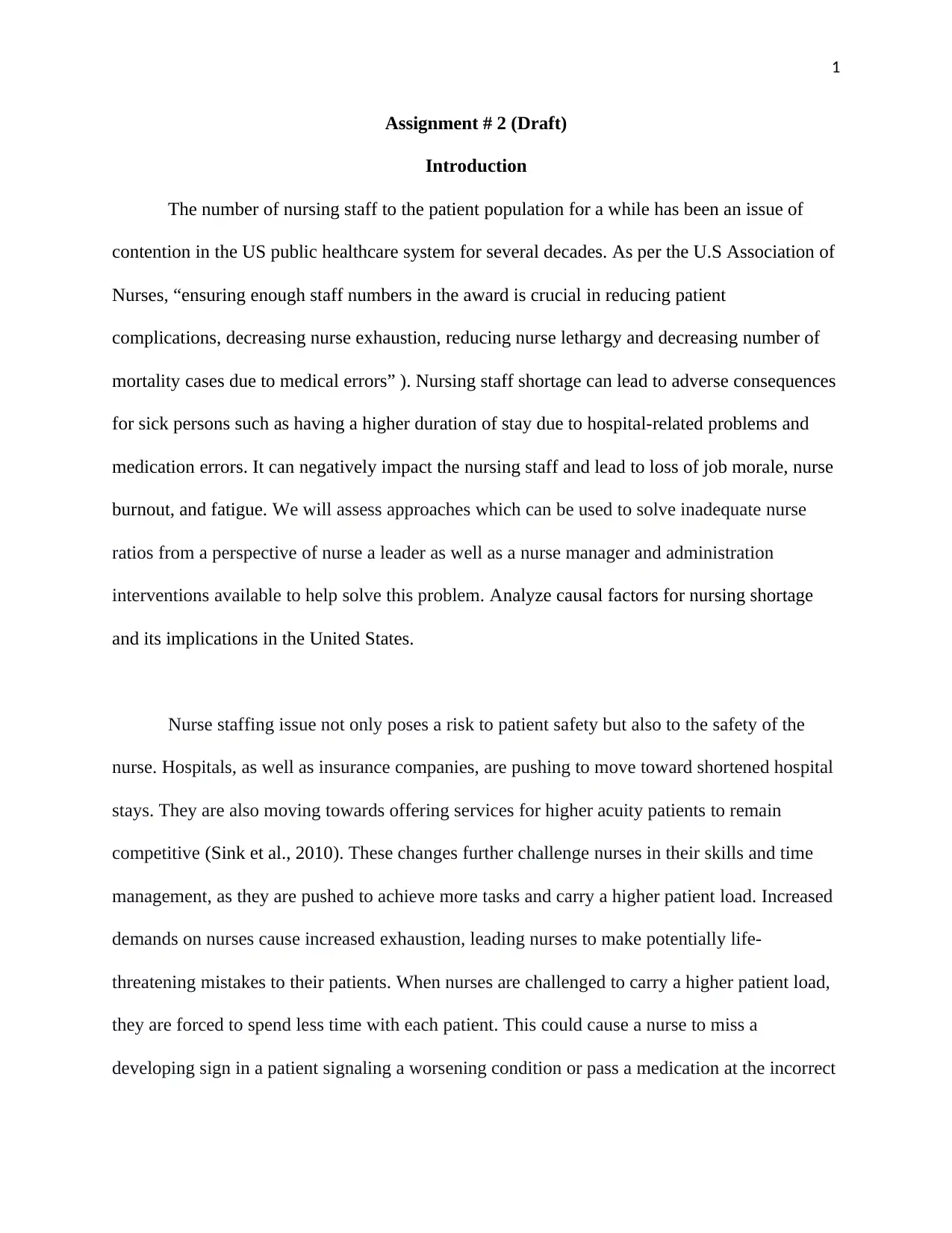
1
Assignment # 2 (Draft)
Introduction
The number of nursing staff to the patient population for a while has been an issue of
contention in the US public healthcare system for several decades. As per the U.S Association of
Nurses, “ensuring enough staff numbers in the award is crucial in reducing patient
complications, decreasing nurse exhaustion, reducing nurse lethargy and decreasing number of
mortality cases due to medical errors” ). Nursing staff shortage can lead to adverse consequences
for sick persons such as having a higher duration of stay due to hospital-related problems and
medication errors. It can negatively impact the nursing staff and lead to loss of job morale, nurse
burnout, and fatigue. We will assess approaches which can be used to solve inadequate nurse
ratios from a perspective of nurse a leader as well as a nurse manager and administration
interventions available to help solve this problem. Analyze causal factors for nursing shortage
and its implications in the United States.
Nurse staffing issue not only poses a risk to patient safety but also to the safety of the
nurse. Hospitals, as well as insurance companies, are pushing to move toward shortened hospital
stays. They are also moving towards offering services for higher acuity patients to remain
competitive (Sink et al., 2010). These changes further challenge nurses in their skills and time
management, as they are pushed to achieve more tasks and carry a higher patient load. Increased
demands on nurses cause increased exhaustion, leading nurses to make potentially life-
threatening mistakes to their patients. When nurses are challenged to carry a higher patient load,
they are forced to spend less time with each patient. This could cause a nurse to miss a
developing sign in a patient signaling a worsening condition or pass a medication at the incorrect
Assignment # 2 (Draft)
Introduction
The number of nursing staff to the patient population for a while has been an issue of
contention in the US public healthcare system for several decades. As per the U.S Association of
Nurses, “ensuring enough staff numbers in the award is crucial in reducing patient
complications, decreasing nurse exhaustion, reducing nurse lethargy and decreasing number of
mortality cases due to medical errors” ). Nursing staff shortage can lead to adverse consequences
for sick persons such as having a higher duration of stay due to hospital-related problems and
medication errors. It can negatively impact the nursing staff and lead to loss of job morale, nurse
burnout, and fatigue. We will assess approaches which can be used to solve inadequate nurse
ratios from a perspective of nurse a leader as well as a nurse manager and administration
interventions available to help solve this problem. Analyze causal factors for nursing shortage
and its implications in the United States.
Nurse staffing issue not only poses a risk to patient safety but also to the safety of the
nurse. Hospitals, as well as insurance companies, are pushing to move toward shortened hospital
stays. They are also moving towards offering services for higher acuity patients to remain
competitive (Sink et al., 2010). These changes further challenge nurses in their skills and time
management, as they are pushed to achieve more tasks and carry a higher patient load. Increased
demands on nurses cause increased exhaustion, leading nurses to make potentially life-
threatening mistakes to their patients. When nurses are challenged to carry a higher patient load,
they are forced to spend less time with each patient. This could cause a nurse to miss a
developing sign in a patient signaling a worsening condition or pass a medication at the incorrect
Paraphrase This Document
Need a fresh take? Get an instant paraphrase of this document with our AI Paraphraser
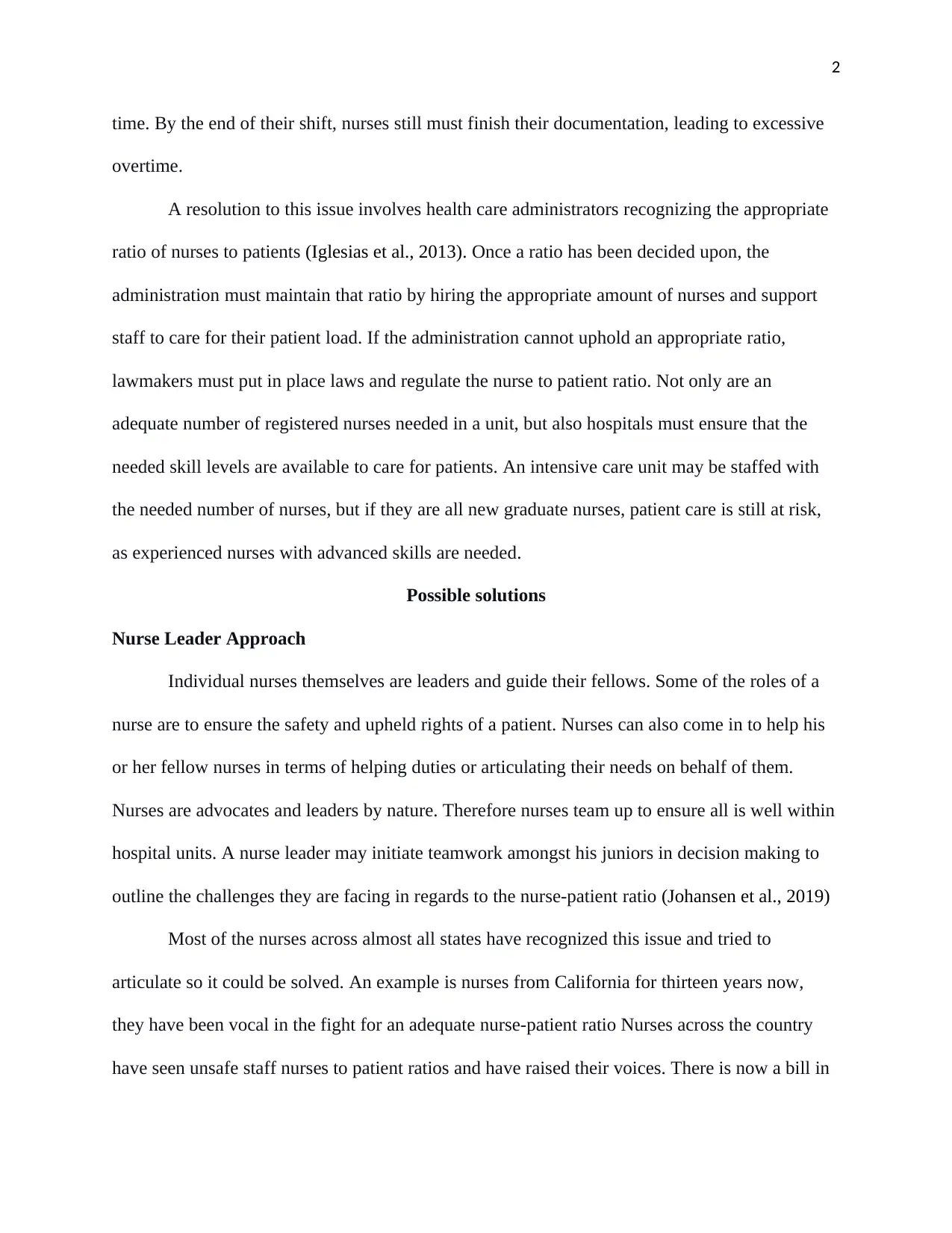
2
time. By the end of their shift, nurses still must finish their documentation, leading to excessive
overtime.
A resolution to this issue involves health care administrators recognizing the appropriate
ratio of nurses to patients (Iglesias et al., 2013). Once a ratio has been decided upon, the
administration must maintain that ratio by hiring the appropriate amount of nurses and support
staff to care for their patient load. If the administration cannot uphold an appropriate ratio,
lawmakers must put in place laws and regulate the nurse to patient ratio. Not only are an
adequate number of registered nurses needed in a unit, but also hospitals must ensure that the
needed skill levels are available to care for patients. An intensive care unit may be staffed with
the needed number of nurses, but if they are all new graduate nurses, patient care is still at risk,
as experienced nurses with advanced skills are needed.
Possible solutions
Nurse Leader Approach
Individual nurses themselves are leaders and guide their fellows. Some of the roles of a
nurse are to ensure the safety and upheld rights of a patient. Nurses can also come in to help his
or her fellow nurses in terms of helping duties or articulating their needs on behalf of them.
Nurses are advocates and leaders by nature. Therefore nurses team up to ensure all is well within
hospital units. A nurse leader may initiate teamwork amongst his juniors in decision making to
outline the challenges they are facing in regards to the nurse-patient ratio (Johansen et al., 2019)
Most of the nurses across almost all states have recognized this issue and tried to
articulate so it could be solved. An example is nurses from California for thirteen years now,
they have been vocal in the fight for an adequate nurse-patient ratio Nurses across the country
have seen unsafe staff nurses to patient ratios and have raised their voices. There is now a bill in
time. By the end of their shift, nurses still must finish their documentation, leading to excessive
overtime.
A resolution to this issue involves health care administrators recognizing the appropriate
ratio of nurses to patients (Iglesias et al., 2013). Once a ratio has been decided upon, the
administration must maintain that ratio by hiring the appropriate amount of nurses and support
staff to care for their patient load. If the administration cannot uphold an appropriate ratio,
lawmakers must put in place laws and regulate the nurse to patient ratio. Not only are an
adequate number of registered nurses needed in a unit, but also hospitals must ensure that the
needed skill levels are available to care for patients. An intensive care unit may be staffed with
the needed number of nurses, but if they are all new graduate nurses, patient care is still at risk,
as experienced nurses with advanced skills are needed.
Possible solutions
Nurse Leader Approach
Individual nurses themselves are leaders and guide their fellows. Some of the roles of a
nurse are to ensure the safety and upheld rights of a patient. Nurses can also come in to help his
or her fellow nurses in terms of helping duties or articulating their needs on behalf of them.
Nurses are advocates and leaders by nature. Therefore nurses team up to ensure all is well within
hospital units. A nurse leader may initiate teamwork amongst his juniors in decision making to
outline the challenges they are facing in regards to the nurse-patient ratio (Johansen et al., 2019)
Most of the nurses across almost all states have recognized this issue and tried to
articulate so it could be solved. An example is nurses from California for thirteen years now,
they have been vocal in the fight for an adequate nurse-patient ratio Nurses across the country
have seen unsafe staff nurses to patient ratios and have raised their voices. There is now a bill in
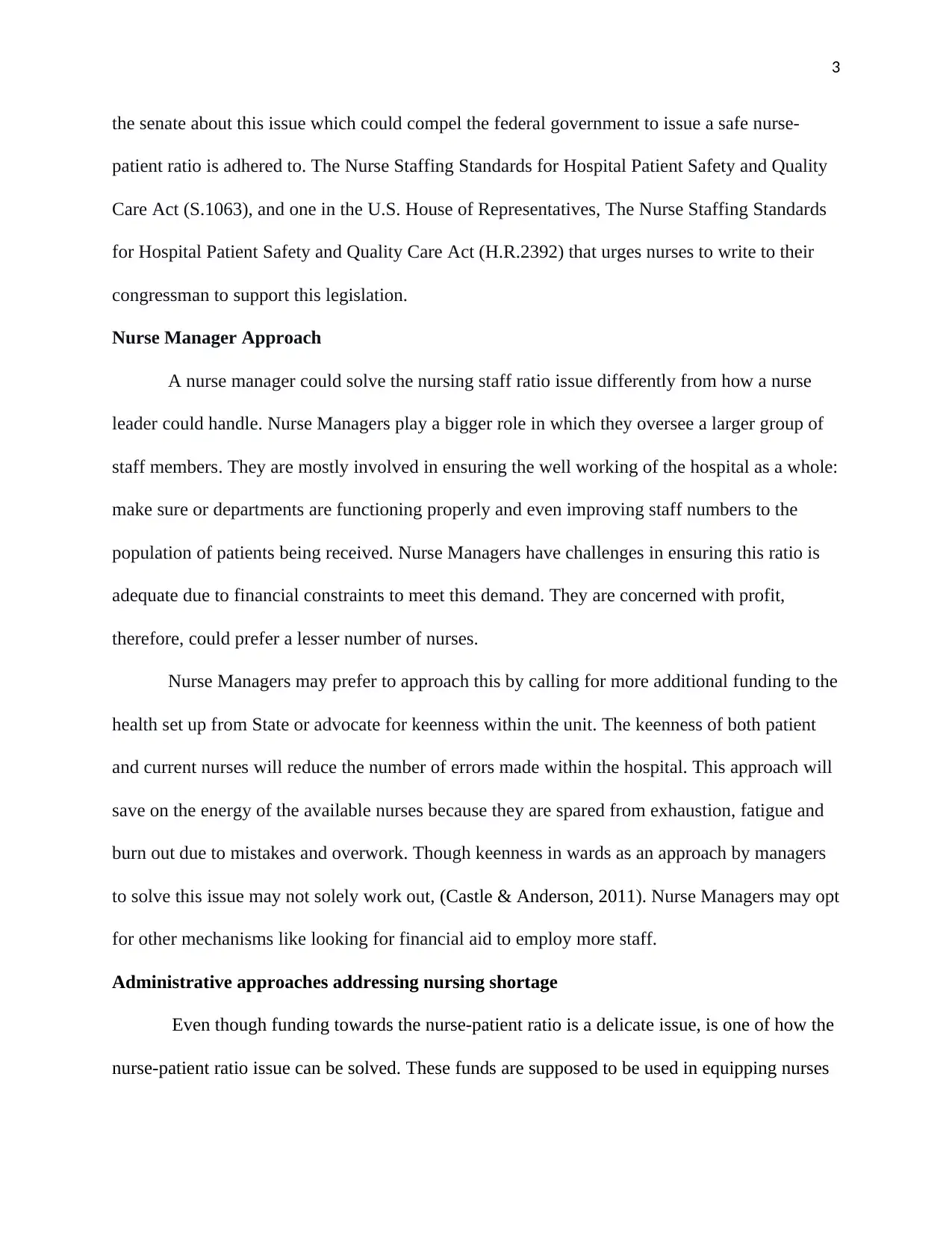
3
the senate about this issue which could compel the federal government to issue a safe nurse-
patient ratio is adhered to. The Nurse Staffing Standards for Hospital Patient Safety and Quality
Care Act (S.1063), and one in the U.S. House of Representatives, The Nurse Staffing Standards
for Hospital Patient Safety and Quality Care Act (H.R.2392) that urges nurses to write to their
congressman to support this legislation.
Nurse Manager Approach
A nurse manager could solve the nursing staff ratio issue differently from how a nurse
leader could handle. Nurse Managers play a bigger role in which they oversee a larger group of
staff members. They are mostly involved in ensuring the well working of the hospital as a whole:
make sure or departments are functioning properly and even improving staff numbers to the
population of patients being received. Nurse Managers have challenges in ensuring this ratio is
adequate due to financial constraints to meet this demand. They are concerned with profit,
therefore, could prefer a lesser number of nurses.
Nurse Managers may prefer to approach this by calling for more additional funding to the
health set up from State or advocate for keenness within the unit. The keenness of both patient
and current nurses will reduce the number of errors made within the hospital. This approach will
save on the energy of the available nurses because they are spared from exhaustion, fatigue and
burn out due to mistakes and overwork. Though keenness in wards as an approach by managers
to solve this issue may not solely work out, (Castle & Anderson, 2011). Nurse Managers may opt
for other mechanisms like looking for financial aid to employ more staff.
Administrative approaches addressing nursing shortage
Even though funding towards the nurse-patient ratio is a delicate issue, is one of how the
nurse-patient ratio issue can be solved. These funds are supposed to be used in equipping nurses
the senate about this issue which could compel the federal government to issue a safe nurse-
patient ratio is adhered to. The Nurse Staffing Standards for Hospital Patient Safety and Quality
Care Act (S.1063), and one in the U.S. House of Representatives, The Nurse Staffing Standards
for Hospital Patient Safety and Quality Care Act (H.R.2392) that urges nurses to write to their
congressman to support this legislation.
Nurse Manager Approach
A nurse manager could solve the nursing staff ratio issue differently from how a nurse
leader could handle. Nurse Managers play a bigger role in which they oversee a larger group of
staff members. They are mostly involved in ensuring the well working of the hospital as a whole:
make sure or departments are functioning properly and even improving staff numbers to the
population of patients being received. Nurse Managers have challenges in ensuring this ratio is
adequate due to financial constraints to meet this demand. They are concerned with profit,
therefore, could prefer a lesser number of nurses.
Nurse Managers may prefer to approach this by calling for more additional funding to the
health set up from State or advocate for keenness within the unit. The keenness of both patient
and current nurses will reduce the number of errors made within the hospital. This approach will
save on the energy of the available nurses because they are spared from exhaustion, fatigue and
burn out due to mistakes and overwork. Though keenness in wards as an approach by managers
to solve this issue may not solely work out, (Castle & Anderson, 2011). Nurse Managers may opt
for other mechanisms like looking for financial aid to employ more staff.
Administrative approaches addressing nursing shortage
Even though funding towards the nurse-patient ratio is a delicate issue, is one of how the
nurse-patient ratio issue can be solved. These funds are supposed to be used in equipping nurses
⊘ This is a preview!⊘
Do you want full access?
Subscribe today to unlock all pages.

Trusted by 1+ million students worldwide
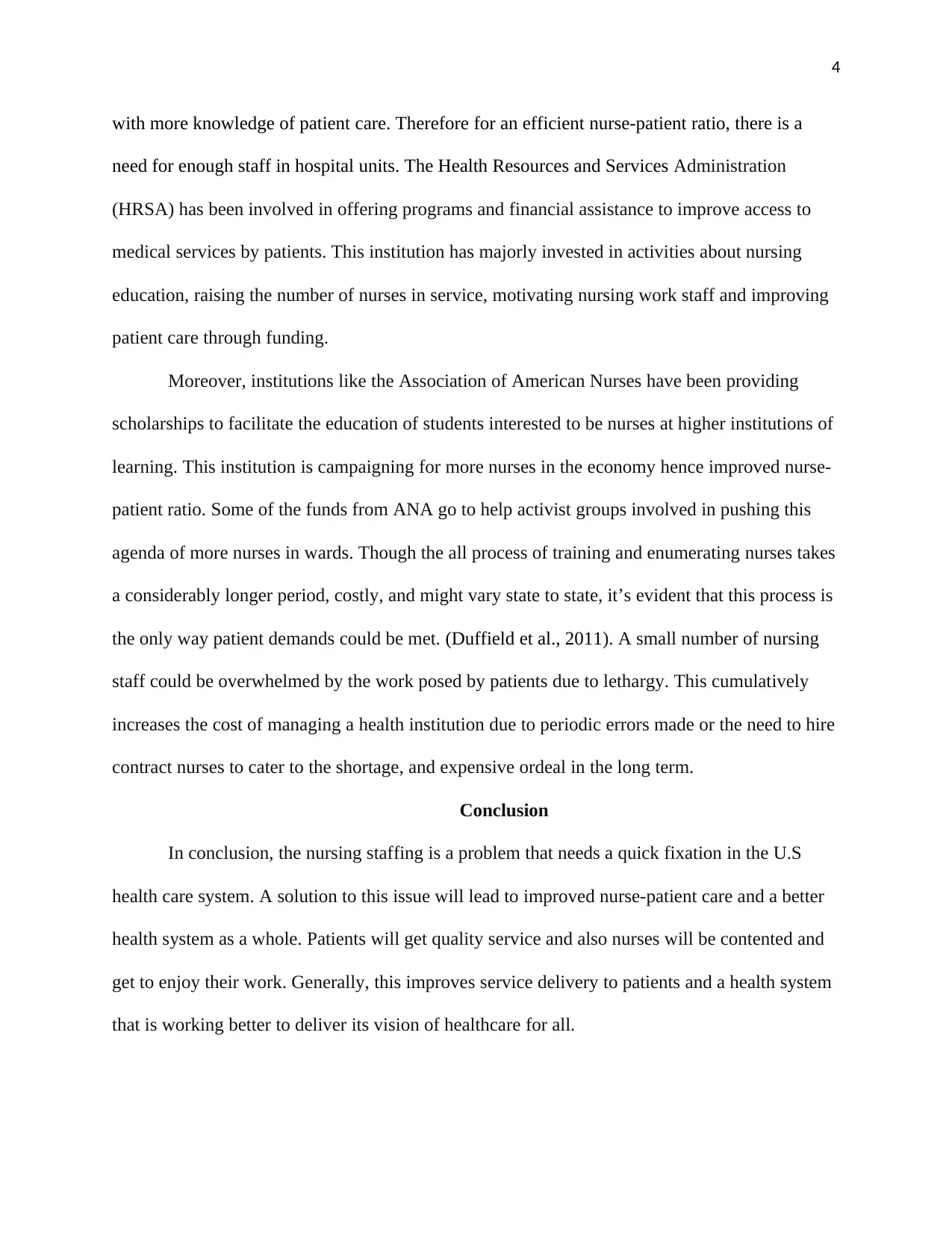
4
with more knowledge of patient care. Therefore for an efficient nurse-patient ratio, there is a
need for enough staff in hospital units. The Health Resources and Services Administration
(HRSA) has been involved in offering programs and financial assistance to improve access to
medical services by patients. This institution has majorly invested in activities about nursing
education, raising the number of nurses in service, motivating nursing work staff and improving
patient care through funding.
Moreover, institutions like the Association of American Nurses have been providing
scholarships to facilitate the education of students interested to be nurses at higher institutions of
learning. This institution is campaigning for more nurses in the economy hence improved nurse-
patient ratio. Some of the funds from ANA go to help activist groups involved in pushing this
agenda of more nurses in wards. Though the all process of training and enumerating nurses takes
a considerably longer period, costly, and might vary state to state, it’s evident that this process is
the only way patient demands could be met. (Duffield et al., 2011). A small number of nursing
staff could be overwhelmed by the work posed by patients due to lethargy. This cumulatively
increases the cost of managing a health institution due to periodic errors made or the need to hire
contract nurses to cater to the shortage, and expensive ordeal in the long term.
Conclusion
In conclusion, the nursing staffing is a problem that needs a quick fixation in the U.S
health care system. A solution to this issue will lead to improved nurse-patient care and a better
health system as a whole. Patients will get quality service and also nurses will be contented and
get to enjoy their work. Generally, this improves service delivery to patients and a health system
that is working better to deliver its vision of healthcare for all.
with more knowledge of patient care. Therefore for an efficient nurse-patient ratio, there is a
need for enough staff in hospital units. The Health Resources and Services Administration
(HRSA) has been involved in offering programs and financial assistance to improve access to
medical services by patients. This institution has majorly invested in activities about nursing
education, raising the number of nurses in service, motivating nursing work staff and improving
patient care through funding.
Moreover, institutions like the Association of American Nurses have been providing
scholarships to facilitate the education of students interested to be nurses at higher institutions of
learning. This institution is campaigning for more nurses in the economy hence improved nurse-
patient ratio. Some of the funds from ANA go to help activist groups involved in pushing this
agenda of more nurses in wards. Though the all process of training and enumerating nurses takes
a considerably longer period, costly, and might vary state to state, it’s evident that this process is
the only way patient demands could be met. (Duffield et al., 2011). A small number of nursing
staff could be overwhelmed by the work posed by patients due to lethargy. This cumulatively
increases the cost of managing a health institution due to periodic errors made or the need to hire
contract nurses to cater to the shortage, and expensive ordeal in the long term.
Conclusion
In conclusion, the nursing staffing is a problem that needs a quick fixation in the U.S
health care system. A solution to this issue will lead to improved nurse-patient care and a better
health system as a whole. Patients will get quality service and also nurses will be contented and
get to enjoy their work. Generally, this improves service delivery to patients and a health system
that is working better to deliver its vision of healthcare for all.
Paraphrase This Document
Need a fresh take? Get an instant paraphrase of this document with our AI Paraphraser
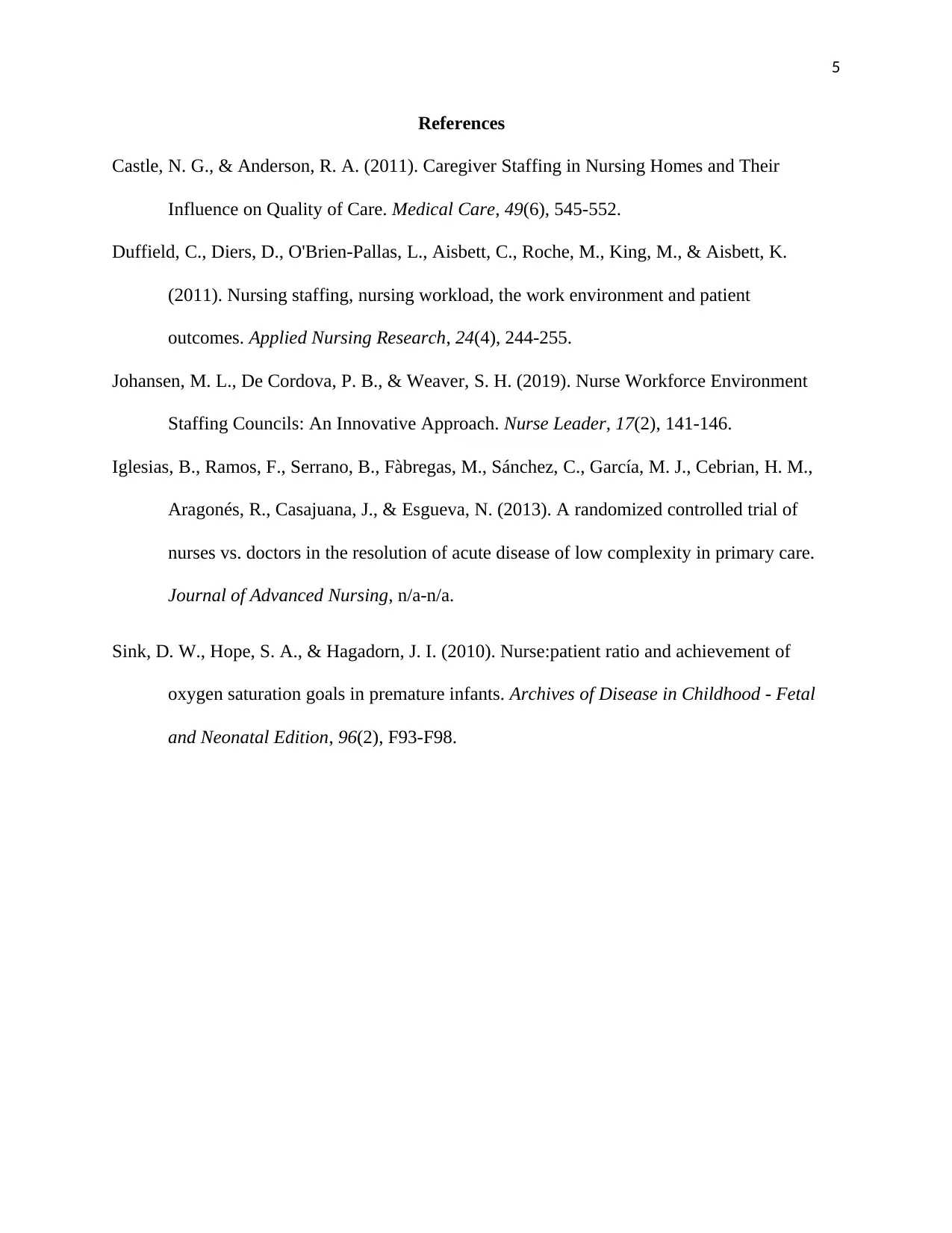
5
References
Castle, N. G., & Anderson, R. A. (2011). Caregiver Staffing in Nursing Homes and Their
Influence on Quality of Care. Medical Care, 49(6), 545-552.
Duffield, C., Diers, D., O'Brien-Pallas, L., Aisbett, C., Roche, M., King, M., & Aisbett, K.
(2011). Nursing staffing, nursing workload, the work environment and patient
outcomes. Applied Nursing Research, 24(4), 244-255.
Johansen, M. L., De Cordova, P. B., & Weaver, S. H. (2019). Nurse Workforce Environment
Staffing Councils: An Innovative Approach. Nurse Leader, 17(2), 141-146.
Iglesias, B., Ramos, F., Serrano, B., Fàbregas, M., Sánchez, C., García, M. J., Cebrian, H. M.,
Aragonés, R., Casajuana, J., & Esgueva, N. (2013). A randomized controlled trial of
nurses vs. doctors in the resolution of acute disease of low complexity in primary care.
Journal of Advanced Nursing, n/a-n/a.
Sink, D. W., Hope, S. A., & Hagadorn, J. I. (2010). Nurse:patient ratio and achievement of
oxygen saturation goals in premature infants. Archives of Disease in Childhood - Fetal
and Neonatal Edition, 96(2), F93-F98.
References
Castle, N. G., & Anderson, R. A. (2011). Caregiver Staffing in Nursing Homes and Their
Influence on Quality of Care. Medical Care, 49(6), 545-552.
Duffield, C., Diers, D., O'Brien-Pallas, L., Aisbett, C., Roche, M., King, M., & Aisbett, K.
(2011). Nursing staffing, nursing workload, the work environment and patient
outcomes. Applied Nursing Research, 24(4), 244-255.
Johansen, M. L., De Cordova, P. B., & Weaver, S. H. (2019). Nurse Workforce Environment
Staffing Councils: An Innovative Approach. Nurse Leader, 17(2), 141-146.
Iglesias, B., Ramos, F., Serrano, B., Fàbregas, M., Sánchez, C., García, M. J., Cebrian, H. M.,
Aragonés, R., Casajuana, J., & Esgueva, N. (2013). A randomized controlled trial of
nurses vs. doctors in the resolution of acute disease of low complexity in primary care.
Journal of Advanced Nursing, n/a-n/a.
Sink, D. W., Hope, S. A., & Hagadorn, J. I. (2010). Nurse:patient ratio and achievement of
oxygen saturation goals in premature infants. Archives of Disease in Childhood - Fetal
and Neonatal Edition, 96(2), F93-F98.
1 out of 5
Related Documents
Your All-in-One AI-Powered Toolkit for Academic Success.
+13062052269
info@desklib.com
Available 24*7 on WhatsApp / Email
![[object Object]](/_next/static/media/star-bottom.7253800d.svg)
Unlock your academic potential
Copyright © 2020–2025 A2Z Services. All Rights Reserved. Developed and managed by ZUCOL.





